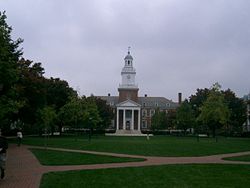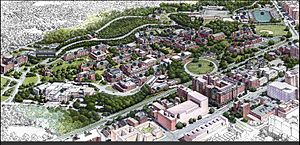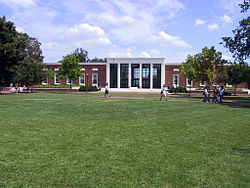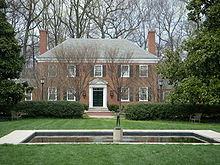- Homewood Campus of Johns Hopkins University
-
The Homewood campus is the main academic and administrative center of the Johns Hopkins University. It is located at 3400 North Charles Street in Baltimore, Maryland. Although Hopkins has several campuses, the Homewood campus and medical campus are the most important. It houses the two major undergraduate schools: the Zanvyl Krieger School of Arts and Sciences and the Whiting School of Engineering.
Contents
History
In his will Johns Hopkins left his summer home, Clifton, to the university for its new campus. But, one of his provisions was that only interest obtained from his stock in the Baltimore and Ohio Railroad could be used to build facilities for the university. Unfortunately, after Johns Hopkins' death, the railroad fell into mismanagement and its eventual collapse was assured by the Panic of 1893 and the stock became worthless. Therefore, the original campus of the University was in downtown Baltimore where buildings were already available. However, this location did not permit room for growth and the trustees began to look for a place to move. Eventually, Hopkins would relocate to the Homewood Estate, where it created the park-like main campus of Hopkins Homewood, set on 140 acres (0.57 km²) in what today lies between the north Baltimore neighborhoods of Charles Village, Guilford, and Hampden.
As a part of the donation, Hopkins was required to donate part of the land for art. As a result, the Baltimore Museum of Art, which has ties to but is not part of the University, is situated next to the University's campus, just southeast of Shriver Hall. North of the campus, also on Charles Street, there is the Evergreen House, one of Hopkins' museums.
The majority of buildings on the portion of North Charles Street that borders Homewood are owned and operated by the university and are informally part of the Homewood campus.
Architecture
The architecture was modeled after the Federal style of Homewood House. Most newer buildings resemble this style, being built of red brick with white marble trim, but lack the details. Homewood House was later used for administrative offices but now is preserved as a museum. The space is organized in quads around Gilman Hall. Some of the main buildings and features include:
- Gilman Hall, designed by Douglas Thomas, was the first major academic building. Based upon Homewood House, it began the tradition of Federal-style academic buildings on campus. Construction began in 1913, and the building was dedicated on May 21, 1915, and named for Daniel Coit Gilman, the first president of the university. Gilman Hall underwent a major 3-year renovation that was completed in 2010.
- Milton S. Eisenhower Library, the main university library.
- The Decker Gardens, bordered by the Greenhouse, Nichols House and the Johns Hopkins Club, were originally known as the Botanical Gardens and were used by members of the Department of Biology to grow plants for research. By the early 1950s, the gardens no longer served an educational purpose, and in 1958, when Nichols House was built as the president's residence, they were completely re-landscaped with aesthetic criteria in mind. In 1976, the gardens were done over again, and named for trustee Alonzo G. Decker, Jr. and members of his family in appreciation for their generosity to Hopkins.
- The statue in the middle of the pool, the Sea Urchin, was sculpted by Edward Berge. It stood in Mount Vernon Place, near the Washington Monument, for 34 years before being replaced by a 7'10" copy, which fit in better with its monumental surroundings. Frank R. Huber, the man who left the city the money to make the copy, asked that the original be given to Paul M. Higinbotham, who donated it to the university. North of the campus, also on Charles Street, we find the Evergreen House, one of Hopkins' museums.
In 1997, the university purchased the vacant 200,000-square-foot (19,000 m2) former Eastern High School, immediately across from Memorial Stadium on East 33rd Street, one mile (1.6 km) east of Homewood. It reopened in 2001, largely occupied by administrative offices.[1]
The University undertook a major renovation of the Homewood campus in 2000-2002, termed "Great Excavations". Asphalt, vehicle-accessible roads throughout the campus were replaced with brick-paved walkways. The traffic circle located in front of the Milton S. Eisenhower Library, which for many years had existed as a half circle that connected to campus roads, was completed, in line with the original Master Plan for the University. Traffic was redirected to the periphery of the campus and greenery was added throughout the campus, with the goal of making the core areas of Homewood safer, more pedestrian-friendly and more attractive.[2] A number of new buildings, including Clark Hall (home to the Biomedical Engineering department), Hodson Hall (a multi-use classroom building), the Mattin Center (a student arts and activities center), the Ralph S. O'Connor Recreation Center, and the New Chemistry Building, were also constructed in the early 2000s.
A second campus expansion called Charles Commons was completed in September 2006, is located across Charles St from Homewood, at 33rd Street between Charles and St. Paul Streets. The approximately 350,000 sq ft (33,000 m2) development includes housing for approximately 618 students, with supporting amenity spaces; a central dining facility and specialty dining area with seating capacity of approximately 330; an approximately 29,000 sq ft (2,700 m2) book store run by Barnes and Noble College Division.
The Decker Quadrangle development constituted the last large building site on the contiguous Homewood campus. Its first phase included a visitors and admissions center (Mason Hall), a computational sciences building (Hackerman Hall),[3] and an underground parking structure, which together created a new quadrangle, south of Garland Hall, named in honor of Alonso G. and Virginia G. Decker. Construction was completed and the new buildings and quadrangle dedicated in 2008. Importantly, the project established a new public entrance for the campus and recognizes the potential for future growth of campus activities sited across Wyman Park Drive.
In 2007, the university announced a $73 million renovation of Gilman Hall, the academic centerpiece of the Homewood Campus. The building had grown labyrinthine over the years, with former library stacks being used as offices and only half the building's stairwells reaching all its floors. The renovation included updates to all classrooms in the building, as well as a full replacement of the building's infrastructure. The renovation involved removal of the bookstore, bank and credit union, creating more space for academic departments. The Hutzler Undergraduate Reading Room was also renovated, and a dedicated film screening room was added. The centerpiece of the renovation was a large glass-roofed atrium, connecting the building's entrance and the Hutzler Reading Room, that now houses the university's premier archaeological collection. The building was formally dedicated on October 23, 2010 as the home of the University's humanities departments.[4]
In early December 2008, the Trustees proposed the construction of a new library addition costing $30 million. The new structure, named the Brody Learning Commons, will augment the existing library, a 185,000-square-foot (17,200 m2) facility built in 1964 and partially renovated in 1998 that will for the most part not change. The building will feature a quiet reading room, 15 new group study rooms, a new atrium and a café. Ground was officially broken on June 6, 2010, with a scheduled completion date of July 2012.[5][6]
The Space Telescope Science Institute is located on the Homewood campus and controls, analyzes, and collects data from the Hubble Space Telescope.
The Johns Hopkins University, working with Collegetown Development Alliance, a joint-venture team composed of Struever Brothers, Eccles & Rouse and Capstone Development, recently[when?] teamed up to develop a mixed-use project featuring student housing, a central dining facility and a major campus book store.
Milton S. Eisenhower Library
The Milton S. Eisenhower Library (called "MSE" by students), is the Johns Hopkins University principal research library and the largest in a network of libraries at Johns Hopkins. This network, known as The Sheridan Libraries, encompasses the Milton S. Eisenhower Library and its collections at the Albert D. Hutzler Reading Room in Gilman Hall (called "The Hut" by students), the John Work Garrett Library at Evergreen House and the George Peabody Library at Mount Vernon Place. Opened in 1964, the library was named for the university's eighth president, Milton S. Eisenhower, brother of former U.S. president Dwight D. Eisenhower, whose vision brought together the university's rich collection of books, journals and other scholarly resources.
The Eisenhower Library collection numbers over 2.6 million volumes and houses over 20,000 journal subscriptions. Strengths in the humanities include German and Romance Languages, Philosophy and the Ancient Near East. In science and engineering, collection strengths include biomedical engineering, chemistry and environmental engineering. The library also offers an extensive array of electronic resources, including full-text books and journals, specialized databases, and statistical and cartographic data. Only two of the MSE library's six stories are above ground, the rest are beneath. However, the architects designed the building so that every level has windows and natural light. The design accords with a bit of traditional campus lore which says no structure on campus can be taller than Gilman Hall, the oldest academic building.
Nichols House
The Nichols House is known as the President's House because, when designed, it was intended to become the residence of the university's president.
The house has a two-story Georgian structure and it was built in 1958. Its construction was funded with the proceeds from the sale of an off-campus building formerly used as the president's house, as well as a large gift from Thomas Nichols, university trustee and president of the Olin Mathieson Chemical Co. It was built to attract Milton S. Eisenhower to come to JHU. Eisenhower was its first resident in 1959, and it continues to house presidents. However, from 1971 to 1996, three presidents declined to occupy it, so it was used to house university guests and as administrative offices. Russian President Boris Yeltsin stayed there, and the house was used as a location during the filming of The Seduction of Joe Tynan.[7] Inl 1996, William R. Brody became the 13th president of the University and opted to once again live at Nichols House.
Lacrosse Museum and National Hall of Fame
The Lacrosse Museum and National Hall of Fame, maintained by US Lacrosse, is on the Homewood campus adjacent to the home field for the lacrosse teams, Homewood Field. Johns Hopkins lacrosse teams have represented the United States in international competition. At the 1928 Summer Olympics in Amsterdam and 1932 Los Angeles Summer Olympics lacrosse demonstration events Hopkins represented the US and team members received Olympic Gold Medals. This was the only such accolade in the history of US college sports. They have also gone to Melbourne, Australia to win the 1974 World Lacrosse Championship.
See also
External links
References
- ^ "OnlineEastern HS Renovations in Full Swing". The Gazette. The Johns Hopkins University. November 6, 2000, VOL. 30, NO. 10. http://www.jhu.edu/~gazette/2000/nov0600/06swing.html.
- ^ "GX Project Background". The Johns Hopkins University. May 13, 2002. http://www.jhu.edu/gx/background/.
- ^ "Computational Science and Engineering Building (CSEB)". Johns Hopkins University. http://engineering.jhu.edu/~cse-building/. Retrieved 2007-10-27.
- ^ "Johns Hopkins to Renovate Gilman Hall". Johns Hopkins University. http://www.jhu.edu/news/home07/apr07/gilman.html. Retrieved 2007-04-14.
- ^ "Johns Hopkins Announces Learning Commons". Johns Hopkins University. http://www.jhu.edu/~gazette/2008/08dec08/08blc.html. Retrieved 2008-12-12.
- ^ "Groundbreaking celebrates start of Brody Learning Commons". Johns Hopkins University. http://gazette.jhu.edu/2010/06/21/groundbreaking-celebrates-start-of-brody-learning-commons/. Retrieved 2010-10-24.
- ^ De Pasquale, Sue (November 1996). "Rolling Out the Welcome Mat". Johns Hopkins Magazine. http://www.jhu.edu/jhumag/1196web/editnote.html. Retrieved 2010-11-20.
Johns Hopkins University Academics Zanvyl Krieger School of Arts and Sciences • Whiting School of Engineering • School of Medicine • Bloomberg School of Public Health • School of Nursing • Nitze School of Advanced International Studies • Peabody Institute • Carey Business School • School of Education • Applied Physics Laboratory • Other Campuses, Research Centers, Institutes and Affiliates
Programs: Center for Talented YouthBuildings Homewood Campus • Milton S. Eisenhower Library • Johns Hopkins Club • Homewood Field • Homewood House • Nichols House • Evergreen House • Baltimore Museum of Art • Space Telescope Science Institute • Peabody Institute Library • Johns Hopkins HospitalHistory Publications Johns Hopkins University Press (Journals & Books) • Project MUSE • Student Publications • Black and Blue JayAthletics Blue Jays • Division I Men's Lacrosse • Centennial Conference • Lacrosse Museum and National Hall of FameStudent life Categories:- Johns Hopkins University
- University and college campuses in the United States
- Geography of Baltimore, Maryland
Wikimedia Foundation. 2010.







